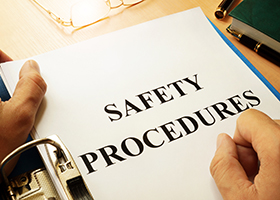
HVAC Unions Keep Members Safe

Workplace safety helps union commercial HVAC technicians to be the best in the field, and this reputation builds trust and loyalty among customers. This training begins on day one when a technician enters the union.
New Jersey union technicians are taught the U.S. Department of Labor Occupational Safety and Health Administration (OSHA) 30 program as one of the first pieces of safety knowledge.
OSHA 30 training, based on federal law, revolves around safe work practices. The course is a comprehensive safety program designed for anyone involved in the construction industry and its taught in the first year of the apprentice training. Courses are offered for journeymen who have not had the training or need an updated class for a job requirement.
All apprentices are also taught and certified in American Red Cross First Aid and CPR the first year of training. The training center also offers refresher and recertification courses.
Safety training doesn’t end with these programs. Safety topics are incorporated into every class and program, ranging from electrical best practices to ladders to defensive driving.
Prevention of Electrocution and Shock
Electrocution or electric shock is one of the biggest safety concerns for anyone working on HVAC equipment. If a technician is not careful, they can gravely injure themselves with electricity.
Electrical safety is a big portion of the electrical training modules throughout all programs, as well as having its own module within the safety curriculum. These safety measures are constantly reinforced because even a small shock can result in cardiac arrest from the disruption it can cause to the heartbeat.
One of the first things the apprentices learn is called “lock out, tag out” to ensure the electric is off and an area is safe to work on. Apprentices are taught to verify there is no electrical power present and meter everything before they work.
Arc Flash Training is a separate module essential for electrical safety since the levels of power used in HVAC systems can cause an explosion. If not careful, these levels of power can be fatal, so proper personal protective equipment and handling are taught in detail to prevent incidents.
Power tool usage, from understanding how to safely operate each tool to what they may be drilling into, is also taught.
Fall Safety
Ladders and fall safety is explained because falls from any distance, especially from roofs where air conditioners are located or high ceilings, can result in serious injury or fatality. Different types of ladders and their proper usage along ladder inspection are discussed in detail. Fall protection measures, such as wearing a lanyard or harness and the use of protected edges, are instilled in all students.
Crane set up, rigging and how to get the units and equipment safely onto roofs is also covered in detail. Mobile work platforms and scaffolding safety are reviewed.
Other Safety Measures
Chemical safety training includes safe handling and proper usage of PVC glues, cleaners and other hazardous chemicals. Proper protective equipment is also covered to prevent chemical burns, other injury and equipment damage. Some of the chemicals used in HVAC equipment is combustible and can explode if mishandled, causing grave harm to the technicians.
Asbestos training is also covered because it was commonly used in older buildings as insulation. Asbestos is a mineral fiber found in rock and soil that is heat resistant that was used in vinyl floor tiles, shingles, textured paint, and insulation products that contain vermiculite. HVAC technicians are often inspecting ductwork as part of servicing a building, so they need to be educated on how to spot asbestos to limit their exposure to it. Exposure to it can cause lung disease, including lung cancer, mesothelioma, and asbestosis.
Fire safety training is covered with torches and soldering equipment to prevent burns.
Defensive driving is covered because most apprentices and journeymen drive company trucks and road safety is the first step to job safety. Apprentices are also taught to drive forklifts to assist in the handling of equipment.
Record keeping on the job site is another important safety skill. Record keeping can include chemical use, equipment conditions and logging equipment in need of repair.
Workplace safety helps union commercial HVAC technicians to be the best in the field, which in turn helps the reputation of every Local. This reputation builds trust and loyalty among customers.
Economic Impact of Safety
Employers pay an estimated $1 billion per week for direct workers’ compensation costs alone, according to the U.S. Department of Labor Occupational Health and Safety Administration.
This $1 billion can be broken into two categories: direct costs, such as workers’ compensation payments, medical expenses or legal costs, and indirect costs that include loss of productivity, accident investigations, hiring and training replacement employees and low morale.
Serious non-fatal work-related injuries cost $58.5 billion in worker’s compensation costs, according to the 2018 Liberty Mutual Workplace Safety Index, which has been done for 18 years. This is a slight increase from 2017 when total costs of all disabling workplace injuries fell to $59.9 billion in 2017, from $61.9 billion in 2016, according to the 2017 Index.
Overexertion is the leading single cause of injury, which costs businesses $13.67 billion in direct costs, followed by falls (two different types) at a combined direct cost of $17.08 billion.
To learn more about safety training and to take advantage of all the benefits the HVAC unions offer, find the Local closest to you now.
- April 24th, 2018
- Blog
- No Comments



